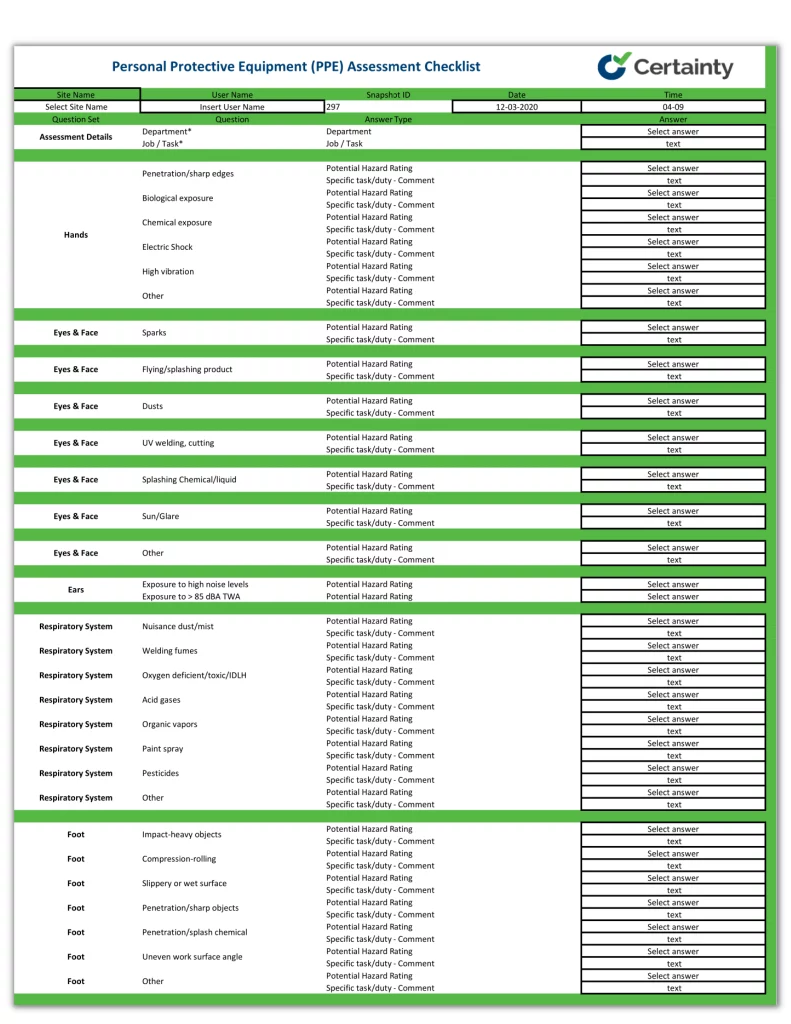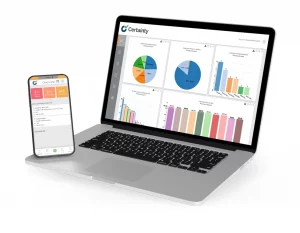What is a PPE Assessment Checklist?
A PPE Assessment Checklist is a tool that helps employers and safety officials evaluate the potential hazards in the workplace and select the appropriate personal protective equipment (PPE) for their workers. More than just a document, it is a practical way of ensuring that workers are protected from the dangers of their jobs. Whether it is physical, chemical, biological, or ergonomic hazards, workers need personal protective equipment (PPE) to prevent or reduce injuries, illnesses, or exposure to harmful substances.

We help make your PPE assessments a success.
Download the PPE Assessment Checklist
Benefits of Using a PPE Assessment Checklist
In addition to being required by law, a PPE Assessment Checklist is an important instrument for guaranteeing the health and safety of employees. Through the use of a PPE Assessment Checklist, safety officials and businesses can:
Protect workers from hazards
To safeguard employees from accidents, diseases, or exposure to dangerous materials, a PPE Assessment Checklist assists in identifying possible risks at work and choosing the proper personal protective equipment. Numerous illnesses and accidents that occur at work, including burns, wounds, eye injuries, hearing loss, lung infections, and skin disorders, can be avoided or at least lessened using PPE.
Comply with safety regulations
A PPE Assessment Checklist helps employers comply with the relevant safety regulations and standards, such as OSHA, ANSI, and CSA. Non-compliance can result in fines, penalties, and legal actions. A PPE Assessment Checklist also helps employers demonstrate due diligence and good faith in providing a safe working environment.
Save money and time
A PPE Assessment Checklist is an invaluable tool that can assist employers in saving both time and money by mitigating the costs and repercussions associated with workplace accidents and illnesses.
Many incidents could have been prevented or minimized through the proper utilization of PPE. This underscores the critical importance and widespread necessity of implementing PPE in various sectors and industries. By incorporating a PPE Assessment Checklist, employers can proactively avoid incurring medical expenses, worker compensation claims, legal liabilities, diminished productivity, and reputational damage.
Improve worker morale and productivity
In addition to promoting worker health and safety, utilizing a PPE Assessment Checklist can significantly enhance employer-employee relations. By demonstrating genuine concern for their well-being, employers can boost worker morale and productivity. When workers feel valued and protected, they are more likely to experience greater satisfaction, motivation, and loyalty. This, in turn, leads to improved performance, adherence to safety regulations, and proactive reporting of potential hazards.
How to Perform a PPE Assessment
As per OSHA regulations, employers must perform a comprehensive PPE evaluation for every job task or operation that poses potential risks to workers from physical, chemical, biological, or environmental hazards. This evaluation involves a series of essential steps:
1. Identify the hazards
Examine the tasks, procedures, resources, tools, and surroundings to pinpoint any potential risks to the well-being of workers. Take into account the nature, severity, and duration of exposure to each hazard. Engage with employees, safety data sheets, labels, manuals, and other sources of information to collect pertinent data.
2. Evaluate the risks
Evaluate each hazard’s risk and degree of disease or injury. Take into account the exposure’s frequency, length, and intensity as well as the efficiency of the current controls. Assess each hazard’s level of danger and prioritize them using a risk matrix or other comparable instrument.
3. Select the PPE
After conducting a thorough risk assessment, it is essential to select the most suitable personal protective equipment (PPE) to safeguard workers against potential hazards. Make sure to refer to the OSHA standards and guidance for specific requirements and recommendations regarding PPE selection for different types of hazards. Additionally, prioritize the comfort, compatibility, and proper fit of the chosen PPE to ensure maximum protection for both the workers and the prevailing work conditions.
4. Provide training and information
Educate workers on the correct utilization, upkeep, preservation, and disposal techniques of personal protective equipment (PPE). Enlighten workers about the potential dangers, the mandatory PPE standards, and the advantages and restrictions of PPE. Guarantee that workers possess a clear comprehension and adhere to the established PPE policies and procedures.
5. Monitor and review
Continuously assess and measure the effectiveness of the PPE. Keep a close eye on the work environment and procedures to guarantee adherence and detect any potential risks or modifications. Reevaluate the PPE evaluation periodically and make necessary updates. Engage with workers for their valuable input and actively involve them in enhancing the PPE program on an ongoing basis.
What the Checklist Includes
This 46-question PPE Audit Checklist ensures that proper PPE requirements are implemented through any type of work that poses as a potential physical risk to workers. Hazards with required PPE covered in the checklist template include some of the following:
- Electrical shock
- Abrasion
- Sharp objects
- Chemical splashes
- Irritants
- Lacerations
- Extreme heat
- Slippery surfaces
- Heavy objects
- Falling objects
and more.

How Certainty Improves PPE Assessments
Using Certainty Software, Personal Protective Equipment (PPE) assessments become easier and generate better actionable information. Whether using our checklist templates or creating your own unique forms, Certainty gives its users the freedom and customizability to support every company’s unique inspection and auditing needs.
Reporting checklist findings at an enterprise-wide level can be filtered to your needs by options such as inspection type, users, site, region, question, or answer. Within your configurable dashboard, you can track issues identified, set up automated notifications and actions, and so much more.

For more on Safety Inspection solutions, click here.
To download this checklist please complete the form below.



